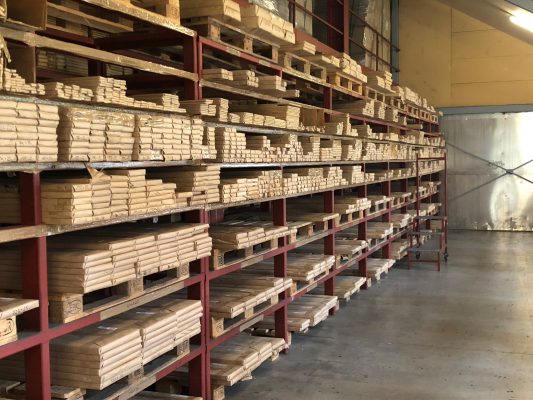What is a steel flat bar?
A steel flat bar is precisely what its name suggests. It is a flat piece of steel formed into a rectangular shape, available in various grades and sizes.
Steel bars are utilised across all trades, including engineering, construction, recycling, and automotive. This is due to the material’s fantastic versatility, making it suitable for an array of applications.
Steel itself is an alloy made from a combination of iron and carbon in varying quantities. Therefore, it is not a metal and won’t be found on the periodic table. Instead, alloys are created to benefit from the characteristics of multiple elements, in this case, iron and carbon, which, when formed together, create one of the strongest, most durable materials we use today – steel.
Types of steel flat bar
As steel is an alloy, there are many different variations available – for example, steel with a higher carbon content or steel with added chromium to make it stainless etc. Unfortunately, this can make it somewhat confusing when finding the correct type of steel flat bar for you. So if you’re looking to purchase steel flat bars and have no idea where to start, why not ask a steel specialist for advice? Sheffield Gauge Plate offer expert guidance and information for all.
Navigating the steel market can be difficult, and so to help narrow down the vast amount of varieties, the material is categorised into four main types:
- Tool Steel
- Carbon Steel
- Stainless Steel
- Alloy Steel
Tool Steel
Tool steels are used for forming, stamping, cutting and shearing. They are usually heat-treated, giving them a higher hardness value, making them ideal for the previously listed purposes. In addition, they have higher levels of elements such as vanadium and tungsten, making them stronger and improving their resistance to heat.
Carbon Steel
As the name suggests, carbon steel differs from its counterparts due to a higher concentration of carbon in the chemical make-up of the alloy. Most steel types typically have a carbon content of anywhere between 0.05% and 0.3%. In comparison, carbon steel has a carbon content of up to 2.5%. The added carbon adds strength to the material, making carbon steel the strongest type of steel. However, this advantage means it is harder to work with as it cannot be bent as easily as other, softer types of steel.
Stainless Steel
Like all steel types, stainless steel is made of a combination of carbon and iron. However, to make a steel ‘stainless’, it must be made of at least 10.5% Chromium. This is the element that gives this type of steel its ‘stainless’ ability. As a result, stainless steel is the most corrosive resistant type of steel out of them all, and it is also 100% recyclable.
Alloy Steel
Alloy steel is quite a ridiculous name for a type of steel, seeing as all steels are alloys by nature. However, the term alloy steel refers to a steel with extra alloying elements, not including iron and carbon. Instead, certain elements are purposefully added into the mix to achieve desired characteristics, e.g. increased malleability or heat resistance. These elements include Manganese, Vanadium, Nickel, and Tungsten.
What is a steel flat bar used for?
Steel flat bars are one of the most versatile materials worldwide and are used across all industries. The durable and robust material is a cornerstone of construction and is suitable for a wide range of uses, including, but not limited to:
- Home appliances – the versatility of steel is utilised across many familiar household features, including fridges and freezers, microwaves, washing machines, garage and overhead doors, latches, heaters, and ductwork.
- Construction and Frames – the bars can take any shape and can be clad with any materials, making them ideal for frame construction. They also carry the added benefit of being pre-fabricated, meaning construction workers can save time on site and not worry about cutting and welding their steel.
- Major works – the reworkability of steel bars makes them ideal for use in cases where structures need replacing or reinforcing. In addition, the strength of this material helps to ensure that a structure remains safe for use.
- Art – the malleability of steel flat bars make it an ideal material for artists looking to create unique displays and uniques pieces. As well as this, DIY crafters often utilise the material for home projects. Due to its affordability and variety of sizes, you can make just about anything you set your mind to, including shelving units, bed frames, ornaments – you name it!
This list is most certainly not a definitive account of the possible uses of steel flat bars. There’s no limit to what you can create from versatile material with the number of different characteristics, shapes, and sizes.
How to bend steel flat bar?
There are several methods you can employ to bend steel flat bars. The way you choose will inevitably depend on the thickness of the steel bar in question.
Thinner steel bars can easily be bent using only a vice and hammer – albeit a heavy hammer and a sturdy vice! If you have a thicker bar, then the steel will require heating. Again, the temperature necessary is also dependant on the thickness; thicker steel will require higher temperatures.
Thicker bars can be heated in multiple ways; however, the most common and probably the easiest way is to simply use a blow torch on the area you intend to bend. Then, when the steel begins to change colour, you can apply pressure, and the steel bar should bend easily.
An alternative method for bending steel bars involves cutting a slot into the bar. The small slot should then enable you to bend the bar more efficiently, and the slot you made can then be welded back together again after you’ve bent it successfully.
How much does steel flat bar cost?
Unfortunately, due to the extensive product variations of steel flat bars, there is no singular answer to this question. With different measurements, thicknesses, grades, and types, it’s impossible to give a price.
However, saying this, steel flat bars are the most cost-effective form of steel. So if you’re looking for steel for a specific project, then nine times out of ten, your best solution will be flat steel bars. In addition, they are relatively cheap to produce for manufacturers, so suppliers don’t have to hike up the price tag to make a profit.
To price up a project, make sure you know the exact size, thickness, grade, and type of steel you need before heading to a supplier. Most steel suppliers have price lists like the one below, or you can contact them directly to receive a personalised quote.
Where to buy steel flat bar
Hundreds and thousands of manufacturers and suppliers in the steel industry will sell you steel flat bars, but you should take the time to compare a few. Then, find a supplier you can trust who has experience in the industry and who won’t take advantage of you!
When purchasing steel flat bars, make sure that you know exactly what you’re after – consider the size (width, length, thickness), type and grade.
Loading recommendations...




After reading your post I know “What is a steel flat bar?”. It’s so google helpful for me right now!
Thank you for posting a good article. Grateful
Thanks for the article. It was great. I’m thinking of translating it into Persian and publishing it on my blog ( https://ahanspot.com ). Is it okay with you?
Useful information. Keep sharing!!!
Really very happy to say, your post is very interesting to read
Thanks a lot for keeping the great stuff. I am very much thankful for this site. This is a particularly nice one and gives in-depth data. Grateful for this not too amazing article.
Put more information on your website like this one, I really like these types of blogs. Very nice blog and articles. I am really very happy to visit your blog. Now I am found what I actually want. I check your blog every day and try to learn something from your blog. Thank you and waiting for your new post.